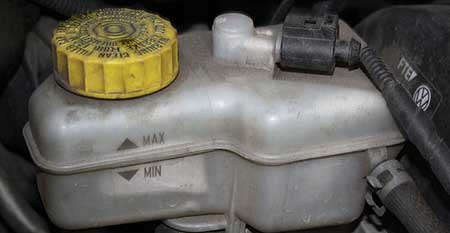Having and maintaining the required brake fuel level is always a good practice that will ensure the correct operation of your braking system. To know the required brake fluid amount for your car, just look in the car manual, there you will find this important piece of information.
The short answer is between 0.55 and 1 liter (18.60 to 33.81 ounces) of brake fluid.
However, drivers are not looking for this info in the car manual, instead, they prefer to look for this answer online, maybe because is much simpler that way, or they are not used to the car manual, or they lost it :).
By the way, when checking the brake fluid level, you will see on the corresponding reservoir a guide that will tell you, or a warning light will appear on your car dashboard.

Contents
Can you just add more brake fluid?
If the brake fluid is below the minimum sign, then you will need to add more, but make sure you don’t have an old fluid because it is not recommended just to add a new brake fluid and combine it with the old one. Instead, you should change the old fluid.
In other words, remember to pay attention to the fluid’s color when checking. New brake fluid has a yellowish color, and If the liquid’s color is dark, then this means that a complete replacement is needed.

If you do, however, have new and clean brake fluid, and you see its level below the minimum mark, add some extra fluid. Also, it does not hurt to check the braking system. Losing brake fluid might indicate a problem with the master brake cylinder gaskets.
When to change the brake fluid?
It is recommended to change the brake fluid every 2-3 years or 40000 – 60000 km (24.854 – 37282 miles). For optimal functioning of the brake system, the fluid must have several properties, as well as meet a certain standard.
To determine a more specific period, you need to look at the brake fluid standard and driving habits. For example, in sports cars, the fluid changes every 5000-10000 km (3100 – 6200 miles) because of the car’s obvious operation conditions.
Brake fluid standards
Most brake fluids are based on American quality standard FMVSS No. 116 (Federal Motor Vehicle Safety Standard), which was developed by the US Department of Transportation, or DOT for short.
So, based on the American standard of quality we can say that there are 5 main classes:
- DOT 3 – used on older cars that have a boiling point of 220°C (428°F)
- DOT 4 – mostly used on modern cars with brake discs on both front and rear. The boiling point occurs at temperatures of 240°C (464°F) and 160°C (320°F).
- DOT 5 – is based on silicone it cannot be added to cars that have an ABS. The boiling point is art 280°C (536°F) and 180°C (356°F). Having a low viscosity, it is generally used in high-speed cars.
- DOT 5.1 – used in faster cars. It is more high-tech than DOT 4 but still absorbs moisture. Often added in cars with ABS and ESP systems. Working temperature 270 ° C (518°F) and 180 ° C (356°F)
- DOT 4+ and DOT 4 SUPER – a modified version of the DOT 4 resisting to slightly higher temperatures 260°C (500°F) and 180°C (356°F).
Why have I specified two boiling point temperatures? The first one represents the temperature of brand-new brake fluid and the second temperature is when the fluid has water in it.
You should know that a braking fluid with 4% or more water in its level needs to be changed.
How long do brake fluids last?
- DOT 3 – 1-2 years
- DOT 4 – 2-3 years
- DOT 5 – 5 years
- DOT 5.1 – 3-4 years
- DOT 4+ and DOT 4 SUPER – 2-3 years
What braking fluid to choose?
When choosing the brake fluid you have the minimum requirements that must be met such as high boiling point, minimal corrosiveness, lubricating properties, and stable viscosity. Choosing a good braking fluid will influence not only the condition of the brake system but also its efficiency.
